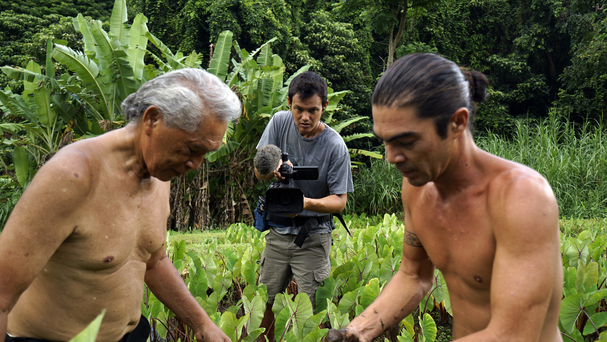
From the Field: Tips on Production Protocol
Sons of Hālawa director and producer, Matt Yamashita shares tips on how to approach cultural protocols in filmmaking.
In documentary filmmaking, access to a story is as important as the story itself. My definition of “access” is: being welcomed into the world of the story that you are trying to tell and being granted permission to tell that story. It’s about earning and maintaining trust with the people and communities that hold the story. Access is not an easy thing to achieve because we, as filmmakers, are required to dive in as deep as possible, often exploring and documenting histories, relationships, and moments that might not be comfortable for our subjects.
How does one earn access? In my experience, it comes through forming relationships, having integrity in your intentions for telling a story, and showing respect for the people and cultures that you are working with.
The bulk of my filmmaking takes place on Molokai, a very small, tightly knit community. I grew up here and know most of the island residents. I also understand the social and cultural protocols that are required in both formal and informal situations. For me, it’s not often difficult to get access to stories because I already have longstanding relationships with the people. In Sons of Halawa, for example, I told the story of Pilipo Solatorio and his family. There were some very emotional and intimate scenes, and audiences often ask, “how were you able to film such sensitive moments?” “It’s simple,” I answer, “I’m part of the family!” The truth is, I’ve been very close with the Solatorio family for years. They know me and trust me, so access was “built-in” on that project. In this respect, I think it’s powerful when filmmakers tell stories that they are close to. Not just because they are likely to be very passionate and knowledgeable about the material, but also because they have a level of access that few others might be able to achieve.
My current project, a biographical documentary about Walter Ritte, poses more of a challenge because he is highly controversial and his story reaches beyond Molokai. Walter is, again, someone I’ve known for years and with whom I have a trusting relationship. The difficulty is accessing interview subjects who are willing to be openly critical about the controversy that Walter has stirred up through the years. To have someone dive deep into controversy and critique is not an easy thing to ask, especially among people who still share the same circles. It’s important for me to relay to interview subjects that I’m not looking to create divisiveness or perpetuate negativity. Rather, my intention is to tell this important story as honestly and accurately as possible while being objective and respectful to all sides. Sometimes it takes months of “talking story” to get to the point where someone feels comfortable and trusting enough to participate. If I am asking for access, I am asking for trust. Trust comes with a lot of responsibility, especially when you live among the people who will be portrayed in your film. For me, all of this boils down to integrity. I believe integrity is the most important quality to bring into the telling of a story. My suggestion, think long and hard about why you want to tell a story and be sure you are telling it for the right reasons. National broadcast documentaries have lasting impacts.
Accessing stories that involve Hawaiian cultural practice, sacred places, or ceremony require even greater levels of trust, integrity, and relationship building. Hawaiian culture has been exploited and misrepresented by media for so many decades that practitioners are now rightfully cautious about filmmakers. In these cases, filmmakers (including the entire production crew) maybe asked to learn about and participate in the very events that they hope to document. This has been required of myself, and I’ve also seen it required of others. My favorite example comes from Kaho’olawe. I was on crew for Toby McLeod’s Standing on Sacred Ground production. Toby spent months gaining the trust necessary to film on Kaho’olawe. In order to document a three-day Makahiki ceremony, he had to agree not to film until the cultural practitioners felt it was allowable, which, Toby was warned, might never be. It was agreed that Toby’s entire 5-man crew would participate in every part of the Makahiki ceremonies until the approval to film was given. They wore traditional malo, learned to introduce themselves in Hawaiian, and helped to prepare and offer ho’okupu at the ceremonial alters. All camera gear remained untouched for nearly two full days. I was deeply impressed with Toby and his crew’s openness and integrity in honoring what was asked of them. They were present, respectful, and willing to immerse themselves. By fully committing themselves to the experience, they earned the trust and respect to shoot events that have never before been documented. Most importantly, the crew members gained a deep sense of understanding and respect for the story they were telling. Needless to say, the end product was a very powerful film.
Toby’s shoot is an extreme example of what it sometimes takes to gain access to a story. But it is also a powerful example of just how rewarding it is to earn that access. Being a documentary filmmaker is not easy. The success of a project is often a direct reflection of the integrity that you bring to the project and your ability to create meaningful relationships. This is an aspect of filmmaking that I truly value, as it encourages me to constantly ask the question, “how can I be a better person so that I can be a better filmmaker?”
Photo: Matt Yamashita, Sons of Hālawa
Categories: Newsletter